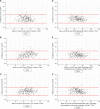Metabolomic profiling to improve glomerular filtration rate estimation: a proof-of-concept study
- PMID: 29718360
- PMCID: PMC6503300
- DOI: 10.1093/ndt/gfy094
Metabolomic profiling to improve glomerular filtration rate estimation: a proof-of-concept study
Abstract
Background: Estimation of glomerular filtration rate (GFR) using estimated glomerular filtration rate creatinine (eGFRcr) is central to clinical practice but has limitations. We tested the hypothesis that serum metabolomic profiling can identify novel markers that in combination can provide more accurate GFR estimates.
Methods: We performed a cross-sectional study of 200 African American Study of Kidney Disease and Hypertension (AASK) and 265 Multi-Ethnic Study of Atherosclerosis (MESA) participants with measured GFR (mGFR). Untargeted gas chromatography/dual mass spectrometry- and liquid chromatography/dual mass spectrometry-based quantification was followed by the development of targeted assays for 15 metabolites. On the log scale, GFR was estimated from single- and multiple-metabolite panels and compared with eGFR using the Chronic Kidney Disease Epidemiology equations with creatinine and/or cystatin C using established metrics, including the proportion of errors >30% of mGFR (1-P30), before and after bias correction.
Results: Of untargeted metabolites in the AASK and MESA, 283 of 780 (36%) and 387 of 1447 (27%), respectively, were significantly correlated (P ≤ 0.001) with mGFR. A targeted metabolite panel eGFR developed in the AASK and validated in the MESA was more accurate (1-P30 3.7 and 1.9%, respectively) than eGFRcr [11.2 and 18.5%, respectively (P < 0.001 for both)] and estimating GFR using cystatin C (eGFRcys) [10.6% (P = 0.02) and 9.1% (P < 0.05), respectively] but was not consistently better than eGFR using both creatinine and cystatin C [3.7% (P > 0.05) and 9.1% (P < 0.05), respectively]. A panel excluding creatinine and demographics still performed well [1-P30 6.4% (P = 0.11) and 3.4% (P < 0.001) in the AASK and MESA] versus eGFRcr.
Conclusions: Multimetabolite panels can enable accurate GFR estimation. Metabolomic equations, preferably excluding creatinine and demographic characteristics, should be tested for robustness and generalizability as a potential confirmatory test when eGFRcr is unreliable.
Keywords: GFR; creatinine; estimating equations; kidney function; metabolomics.
© The Author(s) 2018. Published by Oxford University Press on behalf of ERA-EDTA. All rights reserved.
Figures


References
-
- Levin A, Stevens PE, Bilous RW. et al. KDIGO 2012 clinical practice guideline for the evaluation and management of chronic kidney disease. Kidney Int Suppl 2013; 3: 1–150 - PubMed
-
- Stevens LA, Coresh J, Greene T. et al. Assessing kidney function–measured and estimated glomerular filtration rate. N Engl J Med 2006; 354: 2473–2483 - PubMed
-
- Horio M, Imai E, Yasuda Y. et al. Performance of GFR equations in Japanese subjects. Clin Exp Nephrol 2013; 17: 352–358 - PubMed
Publication types
MeSH terms
Substances
Grants and funding
- N01 HC095161/HL/NHLBI NIH HHS/United States
- N01 HC095168/HL/NHLBI NIH HHS/United States
- N01 HC095167/HL/NHLBI NIH HHS/United States
- N01 HC095159/HL/NHLBI NIH HHS/United States
- N01 HC095163/HL/NHLBI NIH HHS/United States
- UL1 TR000040/TR/NCATS NIH HHS/United States
- N01 HC095166/HL/NHLBI NIH HHS/United States
- N01 HC095160/HL/NHLBI NIH HHS/United States
- UL1 TR001079/TR/NCATS NIH HHS/United States
- N01 HC095169/HL/NHLBI NIH HHS/United States
- N01 HC095162/HL/NHLBI NIH HHS/United States
- R01 DK087961/DK/NIDDK NIH HHS/United States
- N01 HC095165/HL/NHLBI NIH HHS/United States
- N01 HC095164/HL/NHLBI NIH HHS/United States
LinkOut - more resources
Full Text Sources
Other Literature Sources
Medical
Research Materials
Miscellaneous

